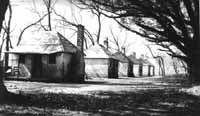Featured Document: Mary Reynolds
 Though rare, slave cabins still dot the landscape of the southern United States. Some are parts of plantation museums, though former quarters are seldom interpreted with the same zeal as the main house. Almost invariably, former slave quarters stand empty today, making it hard to picture the complex and vibrant communities that once occupied them. This month’s featured document is an oral history of Mary Reynolds, who recalls her girlhood growing up on cotton and sugar plantations in Louisiana. Though 105 years old when she narrated her story to a W.P.A. interviewer, Reynolds’ descriptions are vivid (and her contempt for her former master is still sharp). Reynolds’ oral history is one source for understanding the complicated power negotiations between masters and slaves, as slaves raised families, created stories, crafts and music, and sought a measure of autonomy in places designed by and owned by slaveholders. Read Mary Reynolds’ oral history and learn more about the geography of the plantation.
Though rare, slave cabins still dot the landscape of the southern United States. Some are parts of plantation museums, though former quarters are seldom interpreted with the same zeal as the main house. Almost invariably, former slave quarters stand empty today, making it hard to picture the complex and vibrant communities that once occupied them. This month’s featured document is an oral history of Mary Reynolds, who recalls her girlhood growing up on cotton and sugar plantations in Louisiana. Though 105 years old when she narrated her story to a W.P.A. interviewer, Reynolds’ descriptions are vivid (and her contempt for her former master is still sharp). Reynolds’ oral history is one source for understanding the complicated power negotiations between masters and slaves, as slaves raised families, created stories, crafts and music, and sought a measure of autonomy in places designed by and owned by slaveholders. Read Mary Reynolds’ oral history and learn more about the geography of the plantation.
Don’t forget to visit Now and Then: An ASHP blog for updates on ASHP/CML events and other staff musings.
